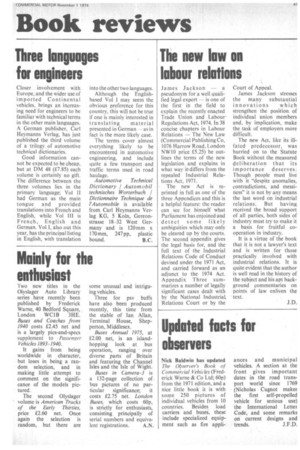The new law on labour relations
Page 45

If you've noticed an error in this article please click here to report it so we can fix it.
James Jackson — a pseudonym for a well qualified legal expert — is one of the first in the field to explain the recently enacted Trade Union and Labour' Regulations Act, 1974. In 38 concise chapters in Labour Relations — The New Law (Commercial Publishing Co, 1076 Harrow Road, London NW10 price £5.25) he outlines the terms of the new legislation and explains in what way it differs from the repealed Industrial Relations Act, 1971.
• The new Act is reprinted in full as one of the three Appendices and this is a helpful feature: the reader can sec for himself what Parliament has enjoined and detect some likely ambiguities which may only be cleared up by the courts. The second appendix gives the legal basis for, and the full text of the Industrial Relations Code of Conduct devised under the 1971 Act, and carried forward as an adjunct to the 1974 Act. Appendix Three summarizes a number of legally significant cases dealt with by the National Industrial Relations Court or by the Court of Appeal.
James Jackson stresses the many substantial innovations which strengthen the position of individual union members and, by implication, make the task of employers more difficult.
The new Act,' like its illfated predecessor, was hurried on to the Statute Book without the measured deliberation that its importance deserves. Though people must live with it "despite anomalies, contradictions, and messiness" it is not by any means the last word on industrial relations. But having received the broad support of all parties, both sides of industry must try to make it a basis for fruitful cooperation in industry.
It is a virtue of the book that it is not a lawyer's text and is written for those practically involved with industrial relations. It is quite evident that the author is well read in the history of the subject and his apt background commentaries on points of law enliven the text.






























































































